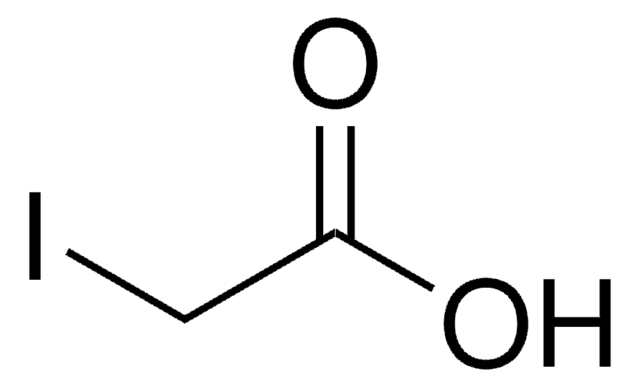Products may be shipped at a different temperature than the recommended long-term storage temperature. If the product quality is sensitive to short-term exposure to conditions other than the recommended long-term storage, it will be shipped on wet or dry-ice. If the product quality is NOT affected by short-term exposure to conditions other than the recommended long-term storage, it will be shipped at ambient temperature. As shipping routes are configured for minimum transit times, shipping at ambient temperature helps control shipping costs for our customers. For more information, please refer to the Storage and Transport Conditions document: https://www.sigmaaldrich.com/deepweb/assets/sigmaaldrich/marketing/global/documents/316/622/storage-transport-conditions-mk.pdf
I6125
Iodoacetamida
≥99% (NMR), crystalline
Sinônimo(s):
α-Iodoacetamide, 2-Iodoacetamide
Selecione um tamanho
Selecione um tamanho
About This Item
Produtos recomendados
fonte biológica
synthetic (organic)
Nível de qualidade
Ensaio
≥99% (NMR)
Formulário
crystalline
pf
92-95 °C (lit.)
solubilidade
H2O: soluble 0.5 M, clear, colorless
temperatura de armazenamento
2-8°C
cadeia de caracteres SMILES
NC(=O)CI
InChI
1S/C2H4INO/c3-1-2(4)5/h1H2,(H2,4,5)
chave InChI
PGLTVOMIXTUURA-UHFFFAOYSA-N
Procurando produtos similares? Visita Guia de comparação de produtos
Aplicação
- Uma estratégia de espectrometria de massa para quantificação de proteína com base na alquilação diferencial de cisteínas usando Iodoacetamida e acrilamida.: Este estudo apresenta um novo método de espectrometria de massa para quantificação de proteínas por cisteínas alquilantes diferencialmente com iodoacetamida e acrilamida, aumentando a precisão da quantificação de proteínas em amostras complexas. (Virág et al., 2024).
- A laminarina melhora a dispepsia funcional induzida por iodoacetamida por meio da modulação dos receptores 5-HT(3) e da microbiota intestinal.: Pesquisas demonstram que a laminarina pode reduzir a dispepsia funcional induzida por iodoacetamida por meio da modulação de receptores 5-HT(3) e da alteração da composição da microbiota intestinal, oferecendo possíveis benefícios terapêuticos. (Liu et al., 2024).
- Proteômica Redox em células melanoma: Um protocolo otimizado.: Este artigo descreve um protocolo proteômico redox otimizado usando iodoacetamida, que facilita a identificação de proteínas sensíveis ao redox em células de melanoma, auxiliando na compreensão da regulação redox no câncer. (Cunha et al., 2024).
- Alvos moleculares da cisplatina em células HeLa explorados por meio de estratégia competitiva de perfil de proteína baseada em atividade.: Utilizando iodoacetamida em perfil de proteína baseado em atividade competitiva, este estudo identifica alvos moleculares da cisplatina em células HeLa, fornecendo percepções sobre os mecanismos do fármaco′. (Chen et al., 2024).
- Desenvolvimento e comparação da reação de conversão de base de 4-tiouridina para citidina.: Essa pesquisa compara as reações de conversão de base envolvendo 4-tiouridina e citidina, com iodoacetamida desempenhando um papel crucial no mecanismo de reação, contribuindo para os avanços na química do nucleotídeo. (Ohashi et al., 2024).
Ações bioquímicas/fisiológicas
Palavra indicadora
Danger
Frases de perigo
Declarações de precaução
Classificações de perigo
Acute Tox. 3 Oral - Aquatic Chronic 4 - Resp. Sens. 1 - Skin Sens. 1
Código de classe de armazenamento
6.1C - Combustible acute toxic Cat.3 / toxic compounds or compounds which causing chronic effects
Classe de risco de água (WGK)
WGK 3
Ponto de fulgor (°F)
Not applicable
Ponto de fulgor (°C)
Not applicable
Equipamento de proteção individual
Eyeshields, Faceshields, Gloves, type P2 (EN 143) respirator cartridges
Escolha uma das versões mais recentes:
Certificados de análise (COA)
Não está vendo a versão correta?
Se precisar de uma versão específica, você pode procurar um certificado específico pelo número do lote ou da remessa.
Já possui este produto?
Encontre a documentação dos produtos que você adquiriu recentemente na biblioteca de documentos.
Os clientes também visualizaram
-
How is shipping temperature determined? And how is it related to the product storage temperature?
1 answer-
Helpful?
-
-
How can I determine the shelf life / expiration / retest date of this product?
1 answer-
If this product has an expiration or retest date, it will be shown on the Certificate of Analysis (COA, CofA). If there is no retest or expiration date listed on the product's COA, we do not have suitable stability data to determine a shelf life. For these products, the only date on the COA will be the release date; a retest, expiration, or use-by-date will not be displayed.
For all products, we recommend handling per defined conditions as printed in our product literature and website product descriptions. We recommend that products should be routinely inspected by customers to ensure they perform as expected.
For products without retest or expiration dates, our standard warranty of 1 year from the date of shipment is applicable.
For more information, please refer to the Product Dating Information document: https://www.sigmaaldrich.com/deepweb/assets/sigmaaldrich/marketing/global/documents/449/386/product-dating-information-mk.pdfHelpful?
-
-
Where can I find an expiration date on sigma aldrich products packages? In particular, I am interested in the shelf life of Iodacetamide, I have I6125-5g, but there are no info on its package or in Product Information document, concerning its exp date.
1 answer-
The expiration date or recommended retest date can be located on the Certificate of Analysis. Please view this sample Certificate of Analysis: https://www.sigmaaldrich.com/certificates/sapfs/PROD/sap/certificate_pdfs/COFA/Q14/I6125-BULKSLCL6241.pdf
This product is not assigned an expiration date. It is given a recommended retest date of roughly three years after the quality release date. A recommended retest date is the period of time during which the product is expected to remain within established stability specifications, provided that it has been stored under defined conditions. After the Retest Date, product samples should be examined to ensure that the product is still in compliance with the established specifications. For more information you may access the "Product Dating Information" document under "ADDITIONAL USEFUL DOCUMENTS ABOUT OUR PRODUCTS" at the bottom of the Quality Services page with this link: https://www.sigmaaldrich.com/US/en/life-science/quality-and-regulatory-management/quality-services.
Helpful?
-
Active Filters
Nossa equipe de cientistas tem experiência em todas as áreas de pesquisa, incluindo Life Sciences, ciência de materiais, síntese química, cromatografia, química analítica e muitas outras.
Entre em contato com a assistência técnica





